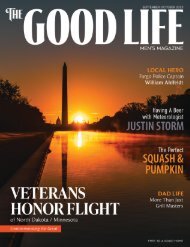The Good Life – September-October 2020
On the cover – Bowhunting: Fun for the entire family. Local Hero donates bone marrow in a lifesaving sacrifice. Having a beer with tv show host Chris Berg and more in Fargo Moorhead's only men's magazine.
On the cover – Bowhunting: Fun for the entire family. Local Hero donates bone marrow in a lifesaving sacrifice. Having a beer with tv show host Chris Berg and more in Fargo Moorhead's only men's magazine.
You also want an ePaper? Increase the reach of your titles
YUMPU automatically turns print PDFs into web optimized ePapers that Google loves.
softness compared to tap water, as well as being free from
chlorine, salts, minerals and other contaminates. Irrigation
for lawns and gardens accounts for a healthy percentage of
household water usage each growing season. Not only does
the rainwater contribute to healthier growth in plants, but it
can also lighten the water bill.
Rain barrels are not the only game in town when it comes to
reducing runoff. Rain gardens are custom-built catchment
basins, populated by water-loving plants, that slowly aid
in water infiltration. Unfortunately, the heavy clay soils
of the Red River Valley do not allow, without substantial
earthwork, the effective installation of rain gardens. Rather
than a rain garden, bioswales or filter strips can be planted
to help reduce runoff contaminates.
At the Cass County Soil Conservation District, we have
helped homeowners with various filter-type plantings. If
you own a home without direct access to a river, creek or
pond, filter strips planted on the downslope of the driveway
is an excellent way to intercept runoff. Driveways and yards
are sloped to shed the water towards the street. Planting
a filter strip of native plants at the toe of the driveway, just
before the water hits the sidewalk or street, will act as a
very effective filter. Water will trickle through the vegetation
before moving onto the river.
If you happen to own land near a stormwater retention pond,
creek or river, there are other options available as well. A
well-manicured turfgrass lawn, sprayed with pesticides
and herbicides and heavily applied with fertilizer, along a
waterway may be the envy of the neighbors. Unfortunately,
turfgrass lawns have poor infiltration rates, losing most of
the rainwater to runoff. Simply planting a strip of native
grasses and forbs as a buffer to the waterway will prevent
contaminants from reaching it.
Best of all native grasses and forbs not only provide
ecological benefits but are beautiful as well. If both warm
and cool-season grasses are selected, as well as forbs with
varying bloom periods, the filter strip can provide an oasis
of beauty and impact.
Water is one of Earth's most precious resources. By
rethinking how rainwater is treated, and taking steps to
minimize pollutants to our rivers, lakes and streams, we
can ensure safe drinking water for the future. •
urbantoadmedia.com / THE GOOD LIFE / 31


















